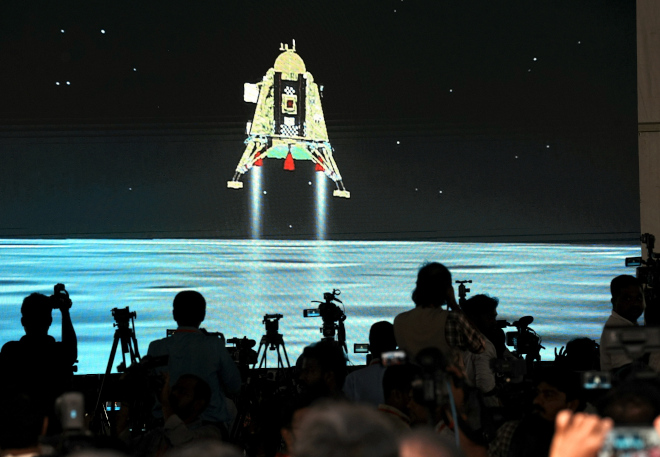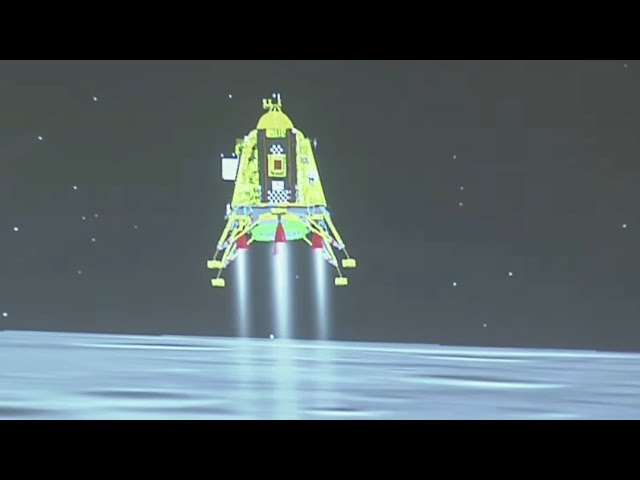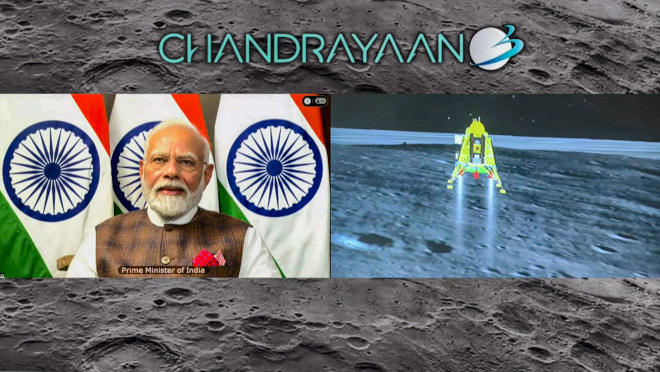
ISRO employees watch the successful soft landing of Chandrayaan-3 on the surface of the moon at ISRO's Telemetry, Tracking and Command Network facility, in Bengaluru, Wednesday, Aug 23, 2023. Photo: PTI.
BENGALURU (PTI): India has reached where no nation has gone before.
In a giant leap for its space programme, India's Moon mission Chandrayaan-3 touched down on the lunar south pole at 6.04 pm on Wednesday, propelling the country to an exclusive club of four and making it the first country to land on the uncharted surface.
With this touchdown on Moon after a flawless 41-day voyage to script history
and less than a week after a Russian lander headed to the lunar south pole crashed, India is the fourth country to master the technology of soft-landing on the Moon after the US, China and erstwhile Soviet Union.
But no country has ever landed on the treacherous south pole that scientists believe could hold important reserves of frozen water and precious elements. Russia's south pole-bound Luna-25 spacecraft crashed into the Moon on Sunday after spinning out of control.
Taking a billion dreams to the Moon in India's second attempt in four years, Chandrayaan-3's four-legged lander Vikram with the 26-kg rover Pragyan in its belly, made the soft landing near the south polar region of the Moon at 6.04 pm successfully negotiating what ISRO scientists described as the "20 minutes of terror" during the crucial powered descent initiated at 5.44 pm.
Shortly after the landing, the Indian Space Research Organisation(ISRO) said on Wednesday night that communication link was established between the lander and the space agency's Mission Operations Complex (MOX) in Bengaluru.
The space agency also released images from the Lander Horizontal Velocity Camera(LHVC) taken during the descent to the Moon's surface.
As scientists at the MOX broke into celebrations and flashed victory signs, Prime Minister Narendra Modi said India is now on the Moon and the success belongs to all humanity.
Modi, who virtually joined from South Africa to witness the culmination of the space odyssey, lauded scientists for their efforts and said the success of the lunar mission has sounded the bugle for India to emerge as a developed nation.
President Droupadi Murmu, union ministers, chief ministers, the scientific and film fraternity and leaders cutting across political spectrum also showered encomiums on the space scientists.
Addressing ISRO scientists from Johannesburg where he is attending the BRICS summit, Modi said India made a resolve "on the Earth and fulfilled it on the Moon".
"This is a moment to cherish forever."
"India is now on the Moon and now is the time to walk on the 'Chandra Path'," the prime minister said.
"We are witness to the new flight of new India. New history has been written."
"India is proving again and again that the sky is not the limit," Modi said, adding ISRO already has set to launch a mission to the sun Aditya-L1' and was planning to explore planet Venus.
ISRO Chief S Somanath said the success of Chandrayaan-3 gives Indian space scientists the confidence to undertake more challenging future missions.
"We have achieved soft landing on Moon. India is on the Moon," he said minutes after ISRO achieved the feat.
Somanath acknowledged the contribution of a generation of leadership and scientists of the country's space agency for the Chandrayaan-3 mission's success, and said the achievement is an "incremental progress" and "a huge one".
"The Honourable PM called me and conveyed his greetings to each one of you and your family for the wonderful work you did in ISRO. Thanks to him for the support he is giving to us for missions like Chandrayaan-3 and missions that are in the offing. That's the great word of comfort that we are receiving for pursuing the inspirational work that we are doing for the nation," Somanath said addressing the ISRO team.
"We went through a lot of pain and agony".
An entire nation held its collective breath as Chandrayaan-3 inched closer to the Moon, finally erupting with joy, as thousands of Indians also gathered in temples, dargahs and gurdwaras to pray for the mission's success.
People assembled in educational institutions, offices, city squares and religious places to watch ISRO's live telecast of Chandrayaan-3's final descent.
Chandrayaan-3 is a follow-on Rs 600 crore mission to Chandrayaan-2 and its objectives after covering a distance of 384,000 km from Earth are to demonstrate safe and soft-landing on the lunar surface, roving on the moon, and to conduct in-situ scientific experiments.
The Chandrayaan-3 mission was launched on July 14 onboard Launch Vehicle Mark-III (LVM-3) rocket, embarking on a more complicated voyage. In all, there were 13 maneuvers including two deboosting ones for the Vikram lander after entering the lunar orbit. The lander was separated from the Propulsion Module(PM) on August 17.
Chandrayaan-2 had failed in its lunar phase when its lander Vikram crashed into the surface of the moon minutes before the touch down following anomalies in the braking system in the lander while attempting a landing on September 7, 2019. Chandrayaan's maiden mission was in 2008.
Somanath had earlier said that the most critical part of the landing was the process of reducing the velocity of the lander from 30 km height to the final landing, and the ability to reorient the spacecraft from horizontal to vertical direction. "This is the trick we have to play here," he had said.
After the soft-landing, the rover is due to descend from the lander's belly, onto the Moon's surface, using one of its side panels, which will act as a ramp. Both have scientific payloads to carry out experiments on the lunar surface and are designed to operate for one lunar daylight period (about 14 Earth days)
There was no immediate word when the six-wheeled rover will be deployed. In the case of Chandrayaan-2 mission, the schedule for the roll out of the rover was four hours after lunar touchdown.
The lander had multiple sensors to ensure a safe touchdown, including an accelerometer, altimeters, Doppler velocimeter, inclinometer, touchdown sensor, and a suite of cameras for hazard avoidance and positional knowledge.
After checking all the parameters and deciding to land, ISRO uploaded all the required commands from its Indian Deep Space Network (IDSN) at Byalalu near Bengaluru, to the Lunar Module(LM), a couple of hours before the scheduled time touchdown.
The lander at around 30 km altitude entered the powered braking phase, and began to use its four thruster engines by "retro firing" them to reach the surface of the moon, by gradually reducing the speed, ISRO officials said. This is to ensure the lander doesn't crash, as the Moon's gravity will also be in play.
On reaching an altitude of around 6.8 km, only two engines were used, shutting down the other two, aimed at giving the reverse thrust to the lander as it descends further, officials said.
At an altitude of about 150-100 metres, the lander, using its sensors and cameras, scanned the surface to check whether there are any obstacles and then start descending to make a soft-landing.
Polar regions of the Moon are a very different terrain due to the environment and the difficulties they present and therefore have remained unexplored. All the previous spacecraft to have reached the Moon landed in the equatorial region, a few degrees latitude north or south of the lunar equator.
The Moon's south pole region is also being explored because there could be a possibility of presence of water in permanently shadowed areas around it.
The LM has payloads including RAMBHA-LP which is to measure the near surface plasma ions and electrons density and its changes, ChaSTE Chandra's Surface Thermo Physical Experiment -- to carry out the measurements of thermal properties of lunar surface near polar region-- and ILSA (Instrument for Lunar Seismic Activity) to measure seismicity around the landing site and delineating the structure of the lunar crust and mantle.
The rover will study the surface of the moon through its payloads APXS - Alpha Particle X-Ray Spectrometer - to derive the chemical composition and infer mineralogical composition to further enhance understanding of the lunar surface.
 Previous Article
Previous Article Next Article
Next Article












The Indian Air Force, in its flight trials evaluation report submitted before the Defence Ministry l..
view articleAn insight into the Medium Multi-Role Combat Aircraft competition...
view articleSky enthusiasts can now spot the International Space Station (ISS) commanded by Indian-American astr..
view article